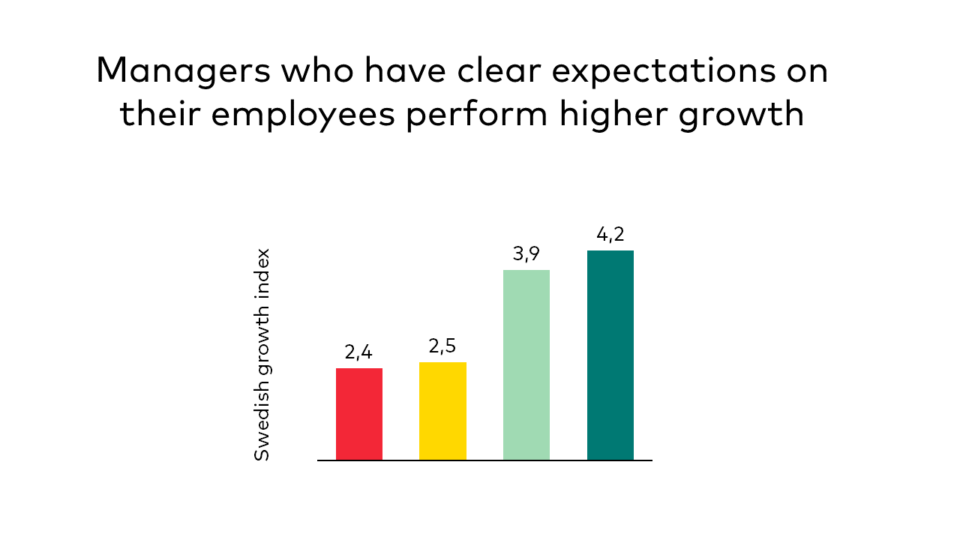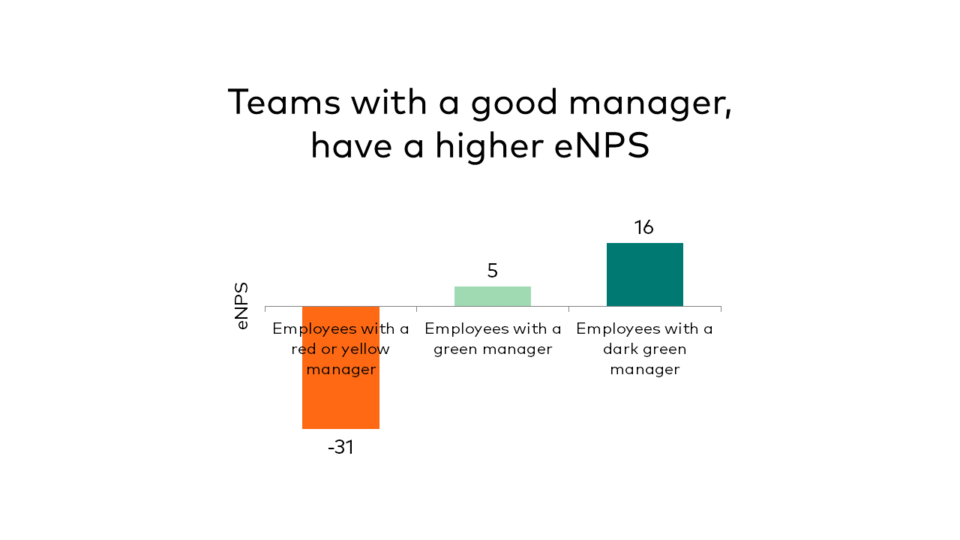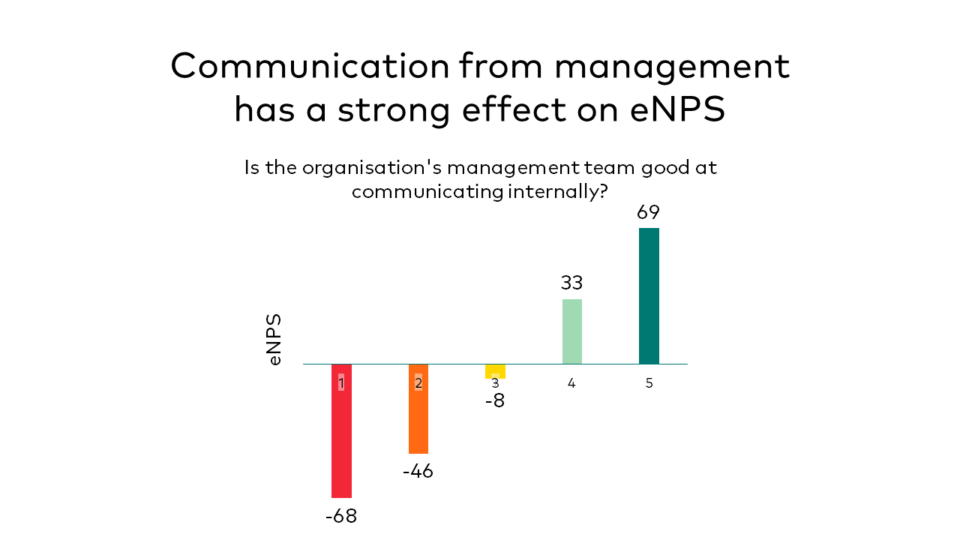Brilliant’s data shows a clear correlation between successful organisations and effective communication from the management team. These organisations excel in creating clarity while ensuring employees feel involved.

- The organisations divided according to how good the managers are at conveying their expectations of the employees, from the 25% where the managers are least clear to the 25% where the managers are most clear.
The analysis is based on 41 service organisations in our database and their rankings according to the Swedish Growth Index. In this analysis, 5 is the highest growth and 1 is the lowest.
Regular and clear communication often creates a sense of transparency. Communicating even during difficult times strengthens the perception of leadership and builds trust. If the management team is uncertain about what to communicate, how often, and on which platforms, the only way to address this is by asking the organisation about its needs. It is through data from such surveys that we at Brilliant learn lessons that can benefit many.
You Must Look Beyond KPIs and Goals
To succeed fully, communicating security is crucial, especially now as the world is a bit shaky. Management teams must clearly articulate how they ensure the organisation is ready for external uncertainties and changes.
Since the pandemic, it has become evident that if something happens outside the organisation, the management team must still be able to lead! This is new for many management teams; now, they must look beyond KPIs and goals and also be able to build trust, security, and safety to collectively show a clear direction forward. Thus, a combination of emotion and clarity is essential. This is a clear need employees have right now.
Guide to Successful Leadership
Why Is Emotion So Important?
Few people jump out of bed feeling:
YES, today I will achieve the company’s KPI of 30% margin!
For us to feel pride and want to recommend the organisation to a friend, you must communicate more than just numbers and KPIs!
Numbers are important; we want profitability and know that engaged employees help organisations increase both profitability and growth in the long run. However, few people are motivated solely by numbers. Thus, emotion is important as a driving force and a very effective rhetorical tool, but you must plan and prepare to convey the right emotion. Together with data and facts, of course!
This is why the management team’s communication and their ability to create the right feeling are so important for employees to see you as an attractive employer.

- The analysis is based on the leadership index of an organisation in the service industry (2023).
Red 0-48 Yellow 49-68 Light Green 69-86 Dark Green 87-100 (7 questions about leadership, value 0-100)
You must create a feeling and communicate in a way that reaches both the heart and the mind!
Rhetoric has many tools for this – to find the balance between clarity and direction forward while also fostering a sense of urgency and genuine pride and purpose.
As a management team, it’s crucial to convey both a clear direction and build emotion and pride for an employee to become loyal and not just satisfied (eNPS), and for them to want to and dare to recommend you as an employer. To justify why it’s important to communicate with emotion using numbers, see the image below. It clearly shows that management teams considered good at communication have much higher eNPS than those that are not. Communication from the management team has a strong effect on eNPS.
eNPS is a good metric to challenge yourself with when building emotion. As an employee, you must truly stand by a recommendation to a friend – changing employers is a big deal with a significant impact on one’s daily life, so it must be good and secure. It’s a very fine compliment for an employee to recommend a friend, as it’s an important decision for the friend, and one wants to stand by it in all situations.

- The study is based on approximately 93,000 responses from over 100 organisations in 2023.
4 Rhetorical Tips – How to Do All This?
How do you as a management team communicate to build a sense of security, pride, and purpose to attract and retain talent?
Here are some initial rhetorical tips to prepare your communication to your employees:
- Start by considering what feeling you want employees to leave your meeting with.
- Do you want to evoke joy, seriousness, security, fear, calm? Which feeling is most important to convey?
- Who is your target audience?
- If you are directing your message to them – what do they need to hear?
- Identify what prior knowledge your employees have about what you will discuss, the context they are currently in, and the feeling they come into the room with, etc. This is what you need to address when you speak, in an understandable, interesting, and inspiring way!
- What is your intention with what you say?
- It’s crucial not to try to cover too much but to be clear with your intention. You also need to consider who you are when you speak. So that you as a sender are clear, make your choices and not talk about everything and nothing, but about exactly what you want the audience to take away. Three is a good number we often use and approximately what a brain can retain and remember😊.
- When you have come this far – finish with a repetition – with what you want the listener to remember – a neat summary in an engaging way – it helps us remember the important things – but what one remembers most is the feeling you manage to convey. The feeling stays forever!
So as a final check – ensure your feeling comes through – in your voice, your body, and with the words you have chosen. Practice beforehand, get feedback from someone you trust, ask if you manage to convey the feeling you want and have decided to leave the audience with.
The data in the studies shown above come from our own database. It is based on our customers’ responses from employee surveys.
Would you like to know more about how your organisation can gain insight into employees’ perceptions of your communication or other insights? Book us for a non-committal meeting, and we’ll tell you more!
